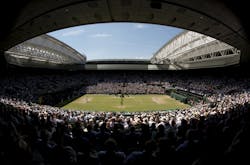If there’s any sporting event I like almost as much as World Cup soccer, it’s Grand Slam tennis! So please forgive me as I indulge in more industrial automation as it’s applied to professional sporting arenas.
Datapaq does in-process temperature profiling to analyze, synthesize and report the effectiveness of industrial heating processes in such industries as photovoltaics, automotive, steel, electronics, ceramics, textiles and food. Now the Cambridge, UK-based company has taken its technology to the courts to monitor the heat coming from the floodlights at Wimbledon.
It might be hard to imagine, but there are actually days in England when the rain lets up enough that Wimbledon officials decide to retract the roof over Centre Court. However, safety and aesthetics dictate that the kilowatt-level floodlights that are mounted on the roof beams cool down sufficiently before pulling the fabric of the roof so close to them. Galliford Try, the company that built the Centre Court for the All England Club, brought on Datapaq to evaluate how soon the lights reach the critical temperature of 212 °F (100 °C) and the roof retract temperature.
On an out-of-season day, Datapaq engineer Kevin Stephens performed a measurement run with three thermocouples mounted above and close to two lights. Connected to the sensors via 33 ft trailing cables, a Q18-type data logger captured the temperature profiles with a 2 s sampling rate. Using a notebook and Datapaq's specialized Insight software, Stephens read out and analyzed the data, marking events such as “lights switched off” or “sensor moved.”
The test proved that the prescribed half-hour wait after the lights are switched off is actually necessary for safe operation. “We now have precise radiant heat temperature data,” said Eugene McCormick, senior project manager at Galliford Try. “We will utilize this information when designing the roof for No. 1 Court.”
Datapaq supplied the full report, showing the temperature curves of all sensors over two and a half hours, during which the floodlights were on for nearly two hours and then switched off to cool down.
For future projects, Wimbledon officials might decide to use Datapaq’s technology to measure the heat coming off of a Venus Williams serve; or perhaps the heat level in the audience when Rafa Nadal removes his shirt after a match. Just an idea…
About the Author
Aaron Hand
Editor-in-Chief, ProFood World

Leaders relevant to this article:
